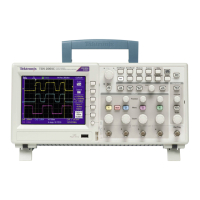Maintenance
Troubleshooting the Power
Supply
To troubleshoo
t the power supply, follow these steps:
1. Remove the rear case. (See page 58, Rear Case.)
2. Use the test oscilloscope to measure the voltages from the power supply
module at J101 on the Main board module. The following table lists the
voltages yo
u should expect to see.
Table 20: Troubleshooting the power supply
Supply Vo ltage range
1
Maximum
current draw
J101 power
pins
J101 return
pins
Derived
supplies
35 V
30 V
DC
to 40 V
DC
floating.
Pin 2 connected to +3.3 V on the Main board.
15 mA 1 2
+28 V LCD
+6 V 5.5 V to 6.5 V 1.0 A 4 3, 5, 8, 10 +5 V
+3.3V 3.0Vto3.6V.
Requires minimum load to maintain regulation.
1.8 A 6, 7 3, 5, 8, 10 3.3 V, +2.5 V
-4 V -5.0 V to -3.5 V 0.8 A 9 3, 5, 8, 10 -2.5 V
Line
trigger
-2 V to 6 V open circuit.
±1 diode drop when attached to the Main board.
1 mA 11 3, 5, 8, 10 Line trigger
1
With 3 W minimum load; still functions with no load.
3. If all of the voltages are present, the Main board is probably defective.
Replace it.
4. If all or some of the voltages are missing, turn off the oscilloscope and
disconnect the cable at connector J101 on the Main board module.
5. Turn on the oscilloscope and check the voltages at the loose end of the cable
disconnected from J101, checking for the same voltages as in step 2.
6. If all of the voltages are missing, check the line fuse on the power supply
module. If the fuse is defective, replace the power supply module.
7. If the fuse is okay, and all or some of the voltages are missing, the power
supply module is probably defective. Replace it.
TDS2000C and TDS1000C-EDU Series Oscilloscope Service Manual 75

